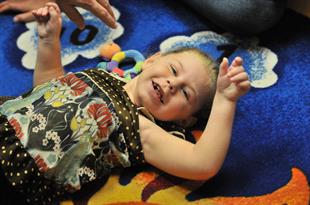A New World for Children with Disabilities
Assistive Technology Partners Helping Families
By Tonia Twichell
 (
(
“I love it when a parent says ‘He won’t mind me,’” Burne, MSM, OTR, says. “We’re thinking, ‘Yay!’”
Helping children with disabilities gain enough independence to make choices—even if questionable ones—is the mission of therapists at two University of Colorado School of Medicine Assistive Technology Partners (ATP) programs.
Tech for Tykes, funded by the Colorado Department of Human Services, helps children up to age 3. StateWide Assistive Technology, Augmentative
“She is happier during the day, she is more communicative and is showing better head control when sitting,” the article notes. “Her mother feels that her attention span has improved and she is showing better cognitive endurance — being able to work on games for longer, etc. She even naps during the day, which she had never done before!”
A common referral, says Burne, ATP’s Early Intervention Program coordinator, is to help kids communicate. But for children with significant physical disabilities, checking for improper alignment of wheelchairs or strollers can be the first priority.
“Imagine if you were sitting at a desk and someone came along and tipped your chair to the side 45 degrees and then said, ‘OK, carry on,’” Burne says. “You can imagine that at least half of your mental energy would be used trying to keep comfortable.”
That was the case when 7-year-old Hannah Metsch came to the ATP clinic near downtown Denver for her quarterly visit this summer from Kaua’i, Hawaii, where there are no assistive technology services. Diagnosed with multiple issues including cerebral palsy and intractable epilepsy, Hannah had recently been
through a new neuroscience therapy called Anat Baneil Method that had worked so well she’d “
 A
A
“I can’t say enough good stuff about them,” Shana, who grew up in Boulder, says of ATP therapists. “They really use their brains. They come up with creative ideas and help me implement them. When something is failing, they tweak it and do something different. They don’t give up.”
Shana
“There are a lot of myths out there that if we use assistive technology with a child it will interfere with normal development, and he won’t be able to walk or talk. Research shows the opposite,” Burne says. “It’s an issue of learned helplessness. Very quickly they learn they can’t do things by themselves and that they have to rely on other people. It changes their whole
Bureaucracy can cause other delays in getting timely help.
“These kids grow in the blink of an eye. By the time (parents) convince the people that they need to convince that a device would be helpful and line up the funding and deal with all the bureaucracy and paperwork, the kid is pretty close to entering preschool. Some kids don’t get technology help until they’re close to
That’s where ATP’s loan bank can be useful. Children receiving early intervention services are eligible to try anything in the
“That way parents can find out if something is a good fit without buying it,” Burne says. “Buying something without trying it can be wasted money.”
Offerings vary from high-tech electronic aids, software
“It’s a cool thing when you have a child who you know has some intellectual ability but who
Shana Metsch understands. She has watched her daughter slowly improve, only to deteriorate when one of her conditions flares. But when things are going well, like they were during her appointment this summer at ATP, she sees possibilities for Hannah to gain some independence despite profound physical and intellectual challenges.
“I’ve always known there was someone in there,” she says of her daughter. “It’s just been hard to prove.”